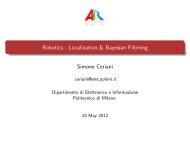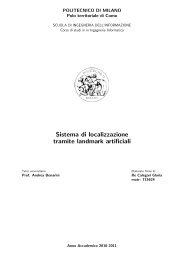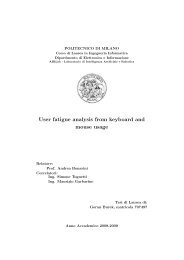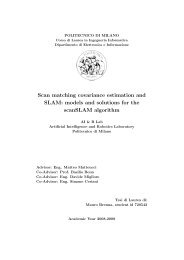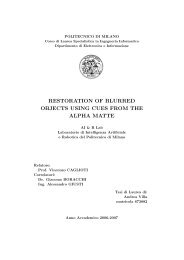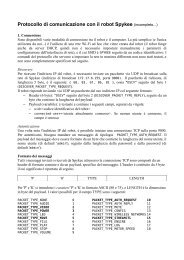Submitted version of the thesis - Airlab, the Artificial Intelligence ...
Submitted version of the thesis - Airlab, the Artificial Intelligence ...
Submitted version of the thesis - Airlab, the Artificial Intelligence ...
You also want an ePaper? Increase the reach of your titles
YUMPU automatically turns print PDFs into web optimized ePapers that Google loves.
64 Chapter 5. Vision<br />
in a form that can be converted into <strong>the</strong> rules. The result <strong>of</strong> <strong>the</strong> color selection<br />
script, with <strong>the</strong> original picture is shown in Figure 5.7.<br />
(a) Mask to be Applied (b) Orginal Picture<br />
Figure 5.7: The mask applied to <strong>the</strong> orginal picture.<br />
The boundaries found for <strong>the</strong> object are converted into rules, that will<br />
add or subtract <strong>the</strong> color from <strong>the</strong> RGB Cube. The rules are checked by<br />
color selection program, provided with <strong>the</strong> ST s<strong>of</strong>tware coming with <strong>the</strong><br />
camera. The script can be found in Appendix B.1 in Color Histogram Calculator.<br />
Using both <strong>the</strong>color selecting program and an <strong>of</strong>fline Matlab script,<br />
we have been able to define <strong>the</strong> color in a more precise way, and improved<br />
<strong>the</strong> results for object detection. But <strong>the</strong> results diverged as <strong>the</strong> lighting<br />
conditions change in <strong>the</strong> environment. For example <strong>the</strong> laboratory where<br />
we have performed tests is exposed to direct sunlight in <strong>the</strong> morning, while<br />
in <strong>the</strong> afternoon it is not. We introduced different configurations for <strong>the</strong><br />
same color, to avoid <strong>the</strong> need for sampling <strong>of</strong> <strong>the</strong> previously defined color.<br />
By controlling <strong>the</strong> color before each run manually and recalculating when<br />
necessary resulted a stable solution to <strong>the</strong> problem.<br />
5.3 Tracking<br />
The final working configuration <strong>of</strong> <strong>the</strong> object detection is made by solving<br />
<strong>the</strong> problems described previously. We can explain <strong>the</strong>se in three titles.<br />
First one is finding <strong>the</strong> correct color information. We start by disabling <strong>the</strong><br />
automatic whitebalanceandautomatic exposurecompensation. Thisallows<br />
us to have <strong>the</strong> color as it is seen directly from <strong>the</strong> camera, by not adjusting




